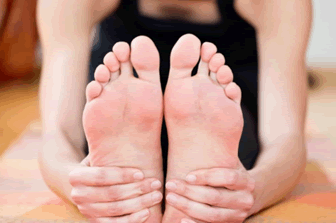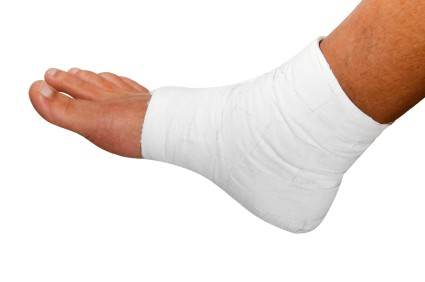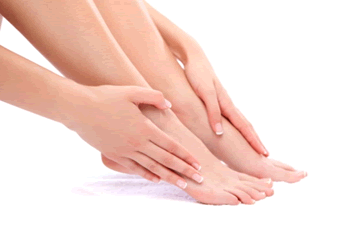 Morton’s neuroma is characterized as the thickening of the tissue surrounding the nerves of the toes. Also known as interdigital neuroma, the condition occurs when the nerves of the toes become irritated and inflamed, which can lead to tingling or numbing sensations. Changing any ill-fitting footwear is important for preventing further progression of Morton’s neuroma. Avoid shoes such as high heels and opt for shoe inserts or custom orthotics to reduce pressure on your toes.
Morton’s neuroma is characterized as the thickening of the tissue surrounding the nerves of the toes. Also known as interdigital neuroma, the condition occurs when the nerves of the toes become irritated and inflamed, which can lead to tingling or numbing sensations. Changing any ill-fitting footwear is important for preventing further progression of Morton’s neuroma. Avoid shoes such as high heels and opt for shoe inserts or custom orthotics to reduce pressure on your toes.
Morton’s Neuroma is a very uncomfortable condition to live with. If you think you have Morton’s neuroma contact one of our podiatrists from Southeast Podiatry. Our doctors can provide the care you need to keep your pain free and on your feet.
Morton’s Neuroma
Morton's neuroma is a painful foot condition that commonly affects the areas between the second and third or third and fourth toe, although other areas of the foot are also susceptible. Morton’s neuroma is caused by an inflamed nerve in the foot that is being squeezed and aggravated by surrounding bones.
What Increases the Chances of having Morton’s Neuroma?
Morton’s neuroma is a very treatable condition. Orthotics and shoe inserts can often be used to alleviate the pain on the forefront of the feet. In more severe cases, corticosteroids can also be prescribed. In order to figure out the best treatment for your neuroma, it’s recommended to seek the care of a podiatrist who can diagnose your condition and provide different treatment options.
If you have any questions, please feel free to contact one of our offices located in Fairhope, Brewton, and Atmore, AL. We offer the newest diagnostic and treatment technologies for all your foot care needs.
 There are many different causes of plantar fasciitis, many of which can be addressed by proper arch supports or custom orthotics. Different causes include tight arches, improper pronation of the feet, and tight calves, all of which can cause inflammation of the plantar fasciia. Stretches for your calf can also help alleviate arch pain. Use a round object like a golf ball to roll under your arch every day, as this is another method to help treat heel pain.
There are many different causes of plantar fasciitis, many of which can be addressed by proper arch supports or custom orthotics. Different causes include tight arches, improper pronation of the feet, and tight calves, all of which can cause inflammation of the plantar fasciia. Stretches for your calf can also help alleviate arch pain. Use a round object like a golf ball to roll under your arch every day, as this is another method to help treat heel pain.
Plantar fasciitis can be very painful and inconvenient. If you are experiencing heel pain or symptoms of plantar fasciitis, contact one of our podiatrists from Southeast Podiatry. Our doctors can provide the care you need to keep your pain free and on your feet.
What is Plantar Fasciitis?
Plantar fasciitis is the inflammation of the thick band of tissue that runs along the bottom of your foot, known as the plantar fascia, and causes mild to severe heel pain.
What Causes Plantar Fasciitis?
· Excessive running
· Non-supportive shoes
· Overpronation
· Repeated stretching and tearing of the plantar fascia
How Can It Be Treated?
· Conservative measures – anti-inflammatories, ice packs, stretching exercises, physical therapy, orthotic devices
· Shockwave therapy – sound waves are sent to the affected area to facilitate healing and are usually used for chronic cases of plantar fasciitis
· Surgery – usually only used as a last resort when all else fails. The plantar fascia can be surgically detached from the heel
While very treatable, plantar fasciitis is definitely not something that should be ignored. Especially in severe cases, speaking to your doctor right away is highly recommended to avoid complications and severe heel pain. Your podiatrist can work with you to provide the appropriate treatment options tailored to your condition.
If you have any questions, please feel free to contact one of our offices located in Fairhope, Brewton, and Atmore, AL. We offer the newest diagnostic and treatment technologies for all your foot care needs.
The plantar fascia is a connective tissue in the heel that stretches across the bottom length of your foot. Plantar fasciitis occurs when the connective tissue becomes inflamed, causing heel pain and discomfort during physical activity. Although the condition is completely treatable, traditional methods can take up to a year to start becoming effective.
Plantar fasciitis is caused by a number of everyday activities, so understanding the condition is important for managing and treating it. One of the most common causes of plantar fasciitis is excessive running, especially with improper fitting or non-supportive shoes. Too much exercise can lead to the plantar fascia being overworked and overstretched, which can cause tears in the tissue. Along with improper fitting shoes, pronation, the rolling of the feet inward, is a common cause of plantar fasciitis. If not treated properly, the plantar fascia becomes overstretched and starts to tear, causing inflammation.
Despite the common causes of plantar fasciitis, there are many different treatment options. For less severe cases, conservative home remedies include taking anti-inflammatory drugs to alleviate pain, applying ice packs to the bottom of your foot and heel, slowly stretching and exercising your feet to re-strengthen the tissue, and using orthotic devices are all ways to help manage your plantar fasciitis.
For more severe cases, shockwave therapy has become a common solution for plantar fasciitis. Shockwave therapy can effectively break up the tissue on the bottom of your foot which facilitates healing and regeneration.This fights the chronic pain caused by plantar fasciitis. Even if this doesn’t work, surgery is always a final option. Surgery on the tissue itself can be done to permanently correct the issue and stop the inflammation and pain in your heels.
No matter what the case may be, consulting your podiatrist is the first and best step to recovery. Even the slightest amount of heel pain could be the first stage of plantar fasciitis. Untreated symptoms can lead to the tearing and overstretching of tissue. Because the tearing of tissue can be compounded if it remains ignored, it canevolve into asevere case. The solution is early detection and early treatment.Talk to your podiatrist about the possibilities of plantar fasciitis if you’re experiencing heel pain.
 Stress fractures are injuries commonly caused by strenuous exercise, so it’s important to take breaks during your exercise routines. It is recommended to slowly increase your strength and endurance over time to prevent stress fractures. Stress fractures are caused by the constant pounding that your bones take over a period of time, as muscles become exhausted from strenuous exercise and are unable to protect the bones. Eating a healthy diet can help prevent stress fractures. Calcium and vitamin D are both important in building and strengthening bones.
Stress fractures are injuries commonly caused by strenuous exercise, so it’s important to take breaks during your exercise routines. It is recommended to slowly increase your strength and endurance over time to prevent stress fractures. Stress fractures are caused by the constant pounding that your bones take over a period of time, as muscles become exhausted from strenuous exercise and are unable to protect the bones. Eating a healthy diet can help prevent stress fractures. Calcium and vitamin D are both important in building and strengthening bones.
Activities where too much pressure is put on the feet can cause stress fractures. To learn more, contact one of our podiatrists from Southeast Podiatry. Our doctors can provide the care you need to keep your pain free and on your feet.
Dealing with Stress Fractures of the foot
The Stress Fractures occur on the foot when muscles in these areas weaken from too much or too little use. Then the Feet lose support when walking or running from the impact of the ground. Since there is no protection the bones receive the full impact of each step. The stress on the feet causes cracks to form in the bones, thus called stress fractures.
What are Stress Fractures?
Stress fractures occur frequently in individuals whose daily activities cause great impact on the Feet. Stress factors are most common among:
-runners
-people affected with Osteoporosis
-play tennis or basketball
-gymnastics
-high impact workouts
Symptoms
Pain from the fractures occur in the area of the fractures, and can be constant or intermittent. It will often cause sharp or dull pain with swelling and tenderness. Engaging in any kind of activity which involves in high impact will aggravate pain.
If you have any questions, please feel free to contact one of our offices located in Fairhope, Brewton, and Atmore, AL. We offer the newest diagnostic and treatment technologies for all your foot care needs.
Stress fractures are small breaks in the bone that are caused by repetitive stress. They typically occur due to overuse, forcing the bones of the foot to continually absorb the full impact of each step someone takes. Stress fractures can also be caused by abnormal foot structure, osteoporosis, bone deformities, or wearing improper footwear during exercise.
Stress fractures are common for individuals whose daily activities cause high levels of impact on their Feet. Individuals who run, play tennis or basketball, or practice gymnastics tend to experience these fractures more frequently. Anyone is susceptible to this problem, though. Individuals who are normally sedentary and suddenly begin an intense, high impact workout may sustain stress fractures. This is because their muscles are not yet strong enough to handle and cushion the intensity of their activity. Osteoporosis may also cause someone to get stress fractures, because the disease weakens an afflicted person's bones and makes it easier for them to break down.
Pain from stress fractures typically occurs in the general area of the fracture. Pain can also manifest as “pinpoint pain” or pain that is felt when the site of the injury is touched, and can be accompanied by swelling. It may occur during or after activity, and it may disappear while resting and return when standing or moving. Engaging in any kind of activity, high impact or otherwise, will aggravate the pain. If the intensity of the activity increases before the stress fracture has properly healed, it can cause a full fracture.
Treatment can vary depending on the individual and the degree of injury. The primary way to treat a stress fracture is to rest the hurt foot. Some fractures will heal quickly with only a little bit of rest, while others may require a long rest period and the use of crutches, immobilization, or physical therapy. Under certain circumstances, surgery may be required to install support pins around the fracture to assist in healing.
If you are undergoing a new exercise regimen in running or some other kind of high impact activity, set incremental goals on a weekly basis so you can build up muscle strength. Make sure to wear supportive shoes to better protect you feet.
If you begin to experience any symptoms of stress fractures, you should stop exercising and rest. If the symptoms persist, consult with your podiatrist. Remembering these tips can help you prevent stress fractures to your foot, and allow you to continue living normally.
 Being a diabetic patient means the risk of neuropathy and the loss of sensation in areas of your body such as the feet. When your feet loses feeling, that means they become at risk for complications like amputation. Neuropathy is caused by severe nerve damage to the feet, which can also “cause changes to the foot structure as the nerves affect muscle function, leading to foot deformities.” Wounds or injuries in the feet may go unnoticed and can become infected. Diabetic patients also have reduced blood circulation, making open wounds more prone to infection.
Being a diabetic patient means the risk of neuropathy and the loss of sensation in areas of your body such as the feet. When your feet loses feeling, that means they become at risk for complications like amputation. Neuropathy is caused by severe nerve damage to the feet, which can also “cause changes to the foot structure as the nerves affect muscle function, leading to foot deformities.” Wounds or injuries in the feet may go unnoticed and can become infected. Diabetic patients also have reduced blood circulation, making open wounds more prone to infection.
Diabetic foot care is important in preventing foot ailments such as ulcers. If you are suffering from diabetes or have any other concerns about your feet contact one of our podiatrists from Southeast Podiatry. Our doctors can provide the care you need to keep your pain free and on your feet.
Diabetic Foot Care
Diabetes affects millions of people every year. Diabetes can damage blood vessels in many parts of the body, including the feet. Because of this, taking care of your feet is essential if you have diabetes, and having a podiatrist help monitor your foot health is highly recommended.
The Importance of Caring for Your Feet
Patients with diabetes should have their doctor monitor their blood levels because blood sugar levels play such a huge role in diabetic care. Monitoring these levels on a regular basis is highly advised.
It is always best to inform your healthcare professional of any concerns you may have regarding your feet, especially for diabetic patients. Early treatment and routine foot examinations are keys to maintaining proper health, especially because severe complications can arise if proper treatment is not applied.
If you have any questions, please feel free to contact one of our offices located in Fairhope, Brewton, and Atmore, AL. We offer the newest diagnostic and treatment technologies for all your foot care needs.
Read more about Diabetic Foot Care
 Exercising as we get older can lead to many different benefits for our bodies. Dr. Harun Durudogan, orthopedic surgeon at Advocate Christ Medical Center, says that “exercise can help strengthen the muscles around the joints and lower the chance of injuries.” Aging means the weakening of bones and muscles and less support for our bodies. It’s important to warm up and stretch before exercising if you are older to avoid injury and joint pain. Exercise can also prevent arthritis and achy joints, so it is recommended for people of all ages.
Exercising as we get older can lead to many different benefits for our bodies. Dr. Harun Durudogan, orthopedic surgeon at Advocate Christ Medical Center, says that “exercise can help strengthen the muscles around the joints and lower the chance of injuries.” Aging means the weakening of bones and muscles and less support for our bodies. It’s important to warm up and stretch before exercising if you are older to avoid injury and joint pain. Exercise can also prevent arthritis and achy joints, so it is recommended for people of all ages.
Proper foot care is something many older adults forget to consider. If you have any concerns about your Feet contact one of our podiatrists from Southeast Podiatry. Our doctors can provide the care you need to keep your pain free and on your feet.
The Elderly and their Feet
As we age we start to notice many changes in our body, but the elder population may not notice them right away. Medical conditions may prevent the elderly to take notice of their foot health right away. Poor vision is a lead contributor to not taking action for the elderly.
Common Conditions
Neuropathy – can reduce feeling in the feet, and can hide many life threating medical conditions.
Reduced flexibility – prevents the ability of proper toenail trimming, and foot cleaning. If left untreated, it may lead to further medical issues.
Foot sores – amongst the older population can be serious before they are discovered. Some of the problematic conditions they may face are:
Gouging toenails affecting nearby toe
Shoes that don’t fit properly
Pressure sores
Loss of circulation in legs & feet
Edema & swelling of Feet
Susceptible Infections
Diabetes and poor circulation can cause general loss of sensitivity over the years, turning a simple cut into a serious issue.
If you have any questions, please feel free to contact one of our offices located in Fairhope, Brewton, and Atmore, AL. We offer the newest diagnostic and treatment technologies for all your foot care needs.
While proper foot care is important for everybody, senior citizens have the tendency to be more susceptible to certain conditions. The elderly should therefore be well informed about any problems that may arise and about what they can do to properly avoid or treat them.
Some of the most common foot problems seniors are susceptible to include foot ulcers, ingrown toenails, fallen arches, and fungal nails. A foot ulcer is an open sore on the foot and can be a result of diabetes and decreased sensation in the feet. An ingrown toenail is defined as when the nail grows into the side of the toe. Fallen arches are indicated by the instep of the foot collapsing. A fungal nails is a condition that results in deformed and discolored toenails.
In order to avoid these conditions it is recommended that the feet be inspected by the patient on a regular basis. If these inspections are carried out routinely, there is a good likelihood that problems can be identified before they become severe, or can even be avoided altogether. If any abnormality is discovered, it is important that the individual consult a podiatrist for diagnosis and information on treatment options.
Proper foot hygiene is also important. Making sure that you always have clean, dry socks on can be a major deterrent to many different problems including bacterial infections, foot odor, and certain types of fungus. Wet feet are a major cause of many of these problems. If your socks get wet, it is important to change them. Walking around in wet socks may not only lead to various infections, but can irritate the skin and result in a number of various complications. Clean, dry feet are less likely to be affected by fungal and other infections.
As people age, the fat present on your feet begins to deteriorate. The protective nature of this fat keeps the feet healthy by providing a barrier between your bones and the ground. This also aids in giving the skin on the feet a certain amount of elasticity. This is one factor that causes elderly people to develop some serious foot issues. Foot moisturizers can be helpful to avoid certain problems associated with this. However, water-based moisturizers do not work as well for elderly people as they do for the young. Instead, it is more effective to use an emollient instead. An emollient is effective because it binds the water in the foot, keeping it from becoming absorbed too readily which will result in dry skin. Emollients also have a special property called occlusion, which provides a layer of oil on the skin. This layer prevents the foot from drying up and can be very effective in treating dry skin disorders. If you can keep the skin on your feet healthy, this will substantially reduce the number of foot problems you will encounter in old age.
Proper footwear is another way to keep feet healthy. Shoes that fit well and provide proper support help prevent ingrown toenails and fallen arches.
Certain medical conditions such as diabetes or poor blood circulation increase the risk for foot issues. For individuals with any of these conditions it is extremely important to conduct regular foot inspections to make sure that there are no sores or infections present.